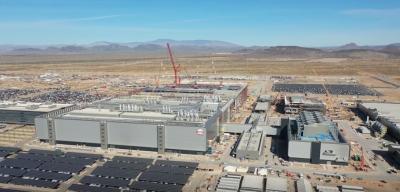Though wildfires that engulfed approximately 370,000 acres in southern California have been contained, there is still a major challenge ahead — cleanup.
To start the process, a $30 million debris removal program has been launched by San Diego County officials to remove the remains of more than 1,800 buildings that were destroyed or damaged.
The California State Office of Emergency Services is funding $23 million of those debris removal costs, while the San Diego County Board of Supervisors is funding the other $7 million.
Since California has experience in handling fire disasters, having encountered wildfires in 2003 that burned 750,000 acres, officials have learned some shortcuts to expedite the clean up process. The advancement of state and county money — $5 million from the state — made it possible to hire a few contractors immediately who can tackle whole communities at once, rather than hire several contractors who could only handle one structure at a time.
The fast tracked plan also means there is no wait for homeowners’ insurance settlements, explained Rex Richardson, media specialist of Solid Waste Management in San Bernardino County. The program will pay for costs up-front, and homeowners and business owners must reimburse the program when they receive insurance money. For those who have no insurance, the cleanup service will be free.
“The governor doesn’t want another Katrina in his state,” Richardson said. He does not want a situation where cleanup and recovery are delayed for months. “Our hope is that because of our efficiency and with the cooperation of FEMA and the State of California, we will have a high rate of participation.”
From previous wildfires in the state, officials also have learned that it is important to remove foundations and chimneys, Richardson said.
“Oftentimes property owners look at the foundation and think there is no problem with it because they can stand on it and so it seems solid.”
But fire weakens the concrete, leaving it with no strength on which to rebuild, he added, explaining that in the past there have been several lots deemed unbuildable because the foundation was not removed and now, after the fact, they are expensive to remove, which adds to the rebuilding cost.
City of San Diego officials have chosen the contractor for their segment of the program, and they hope to complete the cleanup by year’s end. However, the county is in the bidding process to hire the necessary contractors to complete the various phases of cleanup, Richardson said.
By Thanksgiving the first phase of cleanup was completed by the San Diego County Fire Department, which removed hazardous waste such as vehicle batteries, propane tanks, pool chemicals, aerosol cans, paints and solvents, fertilizer, fluorescent lights and household cleaners, Richardson said.
The next phase of cleanup is asbestos abatement. Any structures that were built prior to 1980 have to be surveyed for asbestos. The asbestos survey work and the asbestos removal will be done by two separate contractors, Richardson explained. By the end of November, 42 structures had been surveyed. Samples were sent away for testing; results take several days. If asbestos is found, the property is placed on a list for asbestos removal, awaiting abatement by a certified asbestos contractor.
“Right now proposals are out for a construction manager to handle the asbestos testing and removal portion of the cleanup, but the contractor hadn’t been named as of early December. Once the bids are received we will have a review panel take a look at that and the costs,” Richardson said. Only licensed contractors will be hired. Contractors will be evaluated on whether they can get the work done and whether they have the equipment to do the work. “We’re not necessarily looking for the lowest price,” Richardson added.
“The county has taken the fire area and cut it into four distinct communities, including the Witch Creek Fire, which includes the cities of San Diego, Poway and Escondido; the Harris Fire; Rice Canyon Fire; and the Poomacha Fire, which includes tribal lands for Rincon and La Jolla tribes. The county is asking for bids on any or all of the areas,” Richardson said.
Once the property has been “hazmat-ok’d,” that property is ready to have its debris dealt with under the county’s debris removal program, Richardson said. That contractor had not been named as of early December, but the county’s goal is to have all debris removed before the end of the year.
The final portion of the cleanup process will be erosion control, which is expected to be completed by the end of March, Richardson said.
With so many barren acres the next concern is soil erosion. Discussions are under way to determine how to handle erosion control, which will be necessary should heavy rains begin, as rain would cause mud and debris flows down the mountain side.
An official cost for stabilizing the landscape has not been calculated, but it is expected to exceed $1 million, according to San Diego County’s watershed protection program.
To remove the materials, relatively small equipment is required for the small mountain roads.Maximum weight limits for hazardous waste removal equipment supplied by the contractor has to be less than 65,000 lbs. (29,500 kg).
“The goal is to minimize the impact to the roadways,” Richardson said.
Excavators should be equal to or smaller than a Caterpillar 325, while front end loaders should be equal to or smaller than a Caterpillar 950.
“If a property owner chooses to go it alone and not participate in county program then they pick up the tab. They also hire their own asbestos consultant and then hire a contractor to remove the asbestos, if they need to,” Richardson said. “Once proof of that is done, the county will accept the debris at our landfill. There is no landfill on the mountain so everything comes off. Since we don’t want to handle the debris twice, all fire related debris is being directed to the Mid Valley landfill, which is about 100 mi. north of San Diego.
“Moving and transporting uninspected fire debris poses risks to the health of the workers who are loading and unloading the transport vehicle, as well as residents along the transport route,” Richardson explained. “Disposing of uninspected fire debris also poses risks for the health of disposal site workers and the environment.”
The asbestos will be transported to a landfill in Los Angeles County, which is a class 2 landfill and is permitted to handle asbestos; the next closest asbestos landfill is in Nevada, Richardson explained.
If there is a good side to a fire of this magnitude it is that materials are reduced to about 90 percent of their original state, so there is less to dispose of, Richardson said.
More than 100 mi. (160 km) of roads also were damaged, with repairs estimated at $20 million, according to California Department of Transportation (Caltrans) officials.
“The state highways faired pretty well,” said a Caltrans representative. “We are replacing some signs and guardrails and we’re doing some hydro seeding in the burned areas.”
Guardrails, which were once wood, are now being replaced with metal. Caltrans also is clearing trees that may be in danger of falling on people and roads.
Downed communication lines, water breaks and broken gas pipes that were burning made it dangerous for homeowners to return to their homes so the lines were bled off. Nearly 80,000 customers lost power due to the fires so more than 200 power poles needed to be replaced, which were set by helicopter because of the remote, rugged terrain. CEG
Today's top stories















